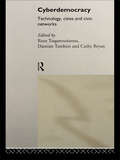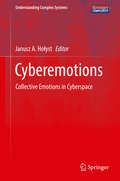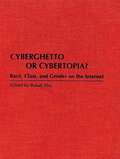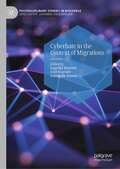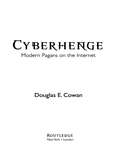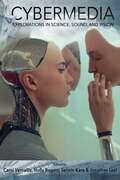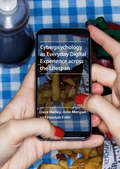- Table View
- List View
Cyberdemocracy: Technology, Cities and Civic Networks (PDF)
by Roza Tsagarousianou Damian Tambini Editors Cathy BryanDevelopments in information technology and the internet are taking place at an almost bewildering pace. Such improvements, however, are believed to present opportunities for improving the responsiveness and accountability of political institutions and enhancing citizen participation. In Cyberdemocracy the theoretical arguments for and against "electronic democracy" and the potential of information and communication technology are closely examined. The book is underpinned by a series of case studies in the US and Europe that demonstrate the application of "electronic democracy" in a number of city and civic projects. Cyberdemocracy provides a balanced and considered evaluation of the potential for "electronic democracy" based on empirical research. It will be a valuable contribution to a vigorous debate about the state of democracy and the influence of information technology. Roza Tsagarousianou is a lecturer and researcher at the Centre for Communication and Information Studies of the University of Westminster. Damian Tambini is a research fellow at Humbolt University, Berlin. Cathy Bryan is a researcher at Informed Sources and is concerned with developments in media and communications technologies.
Cyberdualism in China: The Political Implications of Internet Exposure of Educated Youth (Routledge Contemporary China Series)
by Shiru WangInternet usage in China has recently grown exponentially, rising from 59 million users in 2002 to 710 million by mid-2016. One in every two Chinese has currently been exposed to the Internet. This upsurge has made political communication among citizens and between the government and citizens less costly and almost instantaneous in China. Despite these advances, scholars are only beginning to understand and systematically explain the ways in which increased Internet exposure may affect behavior and values of Chinese netizens. Can the Internet help liberalize Chinese society due to its innate pluralism? Has the Internet become an efficient tool assisting the ruling elite to remain in power given the tendency of Internet service providers and users to be easily manipulated by the Chinese state? This book addresses these questions by focusing on the most digitally embedded segment of Chinese population – university students. Using survey evidence from more than 1200 observations, data confirm that Internet exposure to information generated by fellow netizens promotes democratic orientation, enhances political resistance to indoctrination, and boosts popular nationalism. However, exposure to government-managed websites encourages regime support and, at a less significance level, decreases democratic orientation, and elevates official patriotism. People who perceive the Internet as a tool enhancing the vertical communication between the Chinese government and netizens tend to become patriotic and supportive of the regime. Building upon quantitative evidence, this book draws a nuanced picture of Internet exposure and its political implications.
Cyberdualism in China: The Political Implications of Internet Exposure of Educated Youth (Routledge Contemporary China Series)
by Shiru WangInternet usage in China has recently grown exponentially, rising from 59 million users in 2002 to 710 million by mid-2016. One in every two Chinese has currently been exposed to the Internet. This upsurge has made political communication among citizens and between the government and citizens less costly and almost instantaneous in China. Despite these advances, scholars are only beginning to understand and systematically explain the ways in which increased Internet exposure may affect behavior and values of Chinese netizens. Can the Internet help liberalize Chinese society due to its innate pluralism? Has the Internet become an efficient tool assisting the ruling elite to remain in power given the tendency of Internet service providers and users to be easily manipulated by the Chinese state? This book addresses these questions by focusing on the most digitally embedded segment of Chinese population – university students. Using survey evidence from more than 1200 observations, data confirm that Internet exposure to information generated by fellow netizens promotes democratic orientation, enhances political resistance to indoctrination, and boosts popular nationalism. However, exposure to government-managed websites encourages regime support and, at a less significance level, decreases democratic orientation, and elevates official patriotism. People who perceive the Internet as a tool enhancing the vertical communication between the Chinese government and netizens tend to become patriotic and supportive of the regime. Building upon quantitative evidence, this book draws a nuanced picture of Internet exposure and its political implications.
Cyberemotions: Collective Emotions in Cyberspace (Understanding Complex Systems)
by Janusz A. HolystThis first monograph of its kind introduces the reader to fundamental definitions, key concepts and case studies addressing the following issues of rapidly growing relevance for online communities: What are emotions? How do they emerge, how are they transmitted? How can one measure emotional states? What are cyberemotions? When do emotions and cyberemotions become collective phenomena? How can one model emotions and their changes? What role do emotions play for on-line communities?Edited and authored by leading scientists in this field, this book is a comprehensive reference for anyone working on applications of complex systems methods in the social sciences, as well as for social scientists, psychologists, experts in on-line communities and computer scientists.This book provides an excellent overview of the current state-of-art in research on collective emotional interactions mediated by the Internet. It introduces a reader in social phenomena occurring in cyberspace, algorithms needed for automatic sentiment detection and data driven modeling of emotional patterns observed in on-line groups.Eugene Stanley, Professor, Boston UniversityWith the explosive hyper-exponential growth of the internet suddenly new ways of communication are emerging that give rise to a digital 'Homo empathicus', each of us suddenly being able to share thoughts and feelings with millions if not billions of others. This book is a true treat, a timely milestone that gives us insight in the co-evolution of the way we interact with each other and the communication technology provided through this new seemingly endless flexible digital world. Prof. Holyst did a great job bringing together real experts in the field of cyber emotions.Peter M.A. Sloot, Professor, University of Amsterdam, the Netherlands, Nanyang University, SingaporeThe book Cyberemotions embraces the topic of emotion studies in cyberspace from a very rich spectrum of points of view and applications. It is particularly interesting reading the theoretical foundations underlying the concepts of cyberemotions and how these concepts can be captured, modeled and implemented in real-time applications.Catherine Pelachaud, Director of Research CNRS at LTCI, TELECOM ParisTechLogical machines give us a chance to analyze our often illogical behaviors, especially in the vast meadows of the cyberspace. In this important book, authors of different backgrounds present a wide and deep image, not only of methods of analyzing our emotional behavior online but also how the computers can help to break communicational walls the same technology had built.Rafal Rzepka, Professor, Hokkaido University
Cyberfeminism and Artificial Life
by Sarah KemberCyberfeminism and Artificial Life examines the construction, manipulation and re-definition of life in contemporary technoscientific culture. It takes a critical political view of the concept of life as information, tracing this through the new biology and the discourse of genomics as well as through the changing discipline of artificial life and its manifestation in art, language, literature, commerce and entertainment. From cloning to computer games, and incorporating an analysis of hardware, software and 'wetware', Sarah Kember extends current understanding by demonstrating the ways in which this relatively marginal field connects with, and connects up global networks of information systems.Ultimately, this book aims to re-focus concern on the ethics rather than on the 'nature' of life-as-it-could-be.
Cyberfeminism and Artificial Life
by Sarah KemberCyberfeminism and Artificial Life examines the construction, manipulation and re-definition of life in contemporary technoscientific culture. It takes a critical political view of the concept of life as information, tracing this through the new biology and the discourse of genomics as well as through the changing discipline of artificial life and its manifestation in art, language, literature, commerce and entertainment. From cloning to computer games, and incorporating an analysis of hardware, software and 'wetware', Sarah Kember extends current understanding by demonstrating the ways in which this relatively marginal field connects with, and connects up global networks of information systems.Ultimately, this book aims to re-focus concern on the ethics rather than on the 'nature' of life-as-it-could-be.
CyberGenetics: Health genetics and new media (Genetics and Society)
by Susan Kelly Anna Harris Sally WyattOnline genetic testing services are increasingly being offered to consumers who are becoming exposed to, and knowledgeable about, new kinds of genetic technologies, as the launch of a 23andme genetic testing product in the UK testifies. Genetic research breakthroughs, cheek swabbing forensic pathologists and celebrities discovering their ancestral roots are littered throughout the North American, European and Australasian media landscapes. Genetic testing is now capturing the attention, and imagination, of hundreds of thousands of people who can not only buy genetic tests online, but can also go online to find relatives, share their results with strangers, sign up for personal DNA-based musical scores, and take part in research. This book critically examines this market of direct-to-consumer (DTC) genetic testing from a social science perspective, asking, what happens when genetics goes online?With a focus on genetic testing for disease, the book is about the new social arrangements which emerge when a traditionally clinical practice (genetic testing) is taken into new spaces (the internet). It examines the intersections of new genetics and new media by drawing from three different fields: internet studies; the sociology of health; and science and technology studies. While there has been a surge of research activity concerning DTC genetic testing, particularly in sociology, ethics and law, this is the first scholarly monograph on the topic, and the first book which brings together the social study of genetics and the social study of digital technologies. This book thus not only offers a new overview of this field, but also offers a unique contribution by attending to the digital, and by drawing upon empirical examples from our own research of DTC genetic testing websites (using online methods) and in-depth interviews in the United Kingdom with people using healthcare services.
CyberGenetics: Health genetics and new media (Genetics and Society)
by Susan Kelly Anna Harris Sally WyattOnline genetic testing services are increasingly being offered to consumers who are becoming exposed to, and knowledgeable about, new kinds of genetic technologies, as the launch of a 23andme genetic testing product in the UK testifies. Genetic research breakthroughs, cheek swabbing forensic pathologists and celebrities discovering their ancestral roots are littered throughout the North American, European and Australasian media landscapes. Genetic testing is now capturing the attention, and imagination, of hundreds of thousands of people who can not only buy genetic tests online, but can also go online to find relatives, share their results with strangers, sign up for personal DNA-based musical scores, and take part in research. This book critically examines this market of direct-to-consumer (DTC) genetic testing from a social science perspective, asking, what happens when genetics goes online?With a focus on genetic testing for disease, the book is about the new social arrangements which emerge when a traditionally clinical practice (genetic testing) is taken into new spaces (the internet). It examines the intersections of new genetics and new media by drawing from three different fields: internet studies; the sociology of health; and science and technology studies. While there has been a surge of research activity concerning DTC genetic testing, particularly in sociology, ethics and law, this is the first scholarly monograph on the topic, and the first book which brings together the social study of genetics and the social study of digital technologies. This book thus not only offers a new overview of this field, but also offers a unique contribution by attending to the digital, and by drawing upon empirical examples from our own research of DTC genetic testing websites (using online methods) and in-depth interviews in the United Kingdom with people using healthcare services.
Cyberghetto or Cybertopia?: Race, Class, and Gender on the Internet (Non-ser.)
by Bosah EboComputer-mediated communication and cyberculture are dramatically changing the nature of social relationships. Whether cyberspace will simply retain vestiges of traditional communities with hierarchical social links and class-structured relationships or create new egalitarian social networks remains an open question. The chapters in this volume examine the issue of social justice on the Internet by using a variety of methodological and theoretical perspectives.Political scientists, sociologists, and communications and information systems scholars address issues of race, class, and gender on the Internet in chapters that do not assume any specialized training in computer technology.
Cyberhate in the Context of Migrations (Postdisciplinary Studies in Discourse)
by Angeliki Monnier Axel Boursier Annabelle SeoaneThis edited book takes an interdisciplinary approach to shed light on the complex dynamics involved in the incidence of online hate speech against migrants in user-generated contexts. The authors draw on case studies from Finland, France, Germany, Italy, Poland and the UK, bringing together qualitative and quantitative analyses on user-generated online comments. The authors argue that online hate speech against migrants must be understood as a symptom of a representation crisis on migration, which can only be fully perceived through the study of the complex linguistic, interactional and connective processes within which it emerges. They focus on representations and shared meanings, community building and otherness, and delve into the role of network ecosystems in the process of the construction of public problems. This book will be of interest to undergraduate and post-graduate students as well as academics working on hate speech and migration studies in a variety of fields, and can also contribute to improving research protocols for automated analyses and detections of online hate speech.
Cyberhenge: Modern Pagans on the Internet
by Douglas E. CowanCyberhenge examines the use of Internet technology in shaping religious traditions and rituals. Cowan asks how and why Neopaganism has embraced the Internet in such an innovative and imaginative way.
Cyberhenge: Modern Pagans on the Internet
by Douglas E. CowanCyberhenge examines the use of Internet technology in shaping religious traditions and rituals. Cowan asks how and why Neopaganism has embraced the Internet in such an innovative and imaginative way.
Cyberidentities At War: The Moluccan Conflict on the Internet (EASA Series #20)
by Birgit BräuchlerConflicting parties worldwide increasingly use the Internet in a strategic way, and struggles carried out on a local level achieve a new dimension. This new kind of medialization results in a conflict’s expansion into global cyberspace. Based on ethnographic research on the online activities of Christian and Muslim actors in the Moluccan conflict (1999–2003), this study investigates processes of identity construction, community building and evolving conflict dynamics on the Internet. In contributing to conflict and Internet research, this study paves the way for a new cyberanthropology. A newly added epilogue outlines the directions in which the situation in the Moluccas has continued and discusses the advances and developments of theoretical and methodological concerns presented in the 2005 German edition.
Cyberkriminologie: Kriminologie für das digitale Zeitalter
Können bisherige kriminologische Theorien und Erkenntnisse auf die Regeln des digitalen Raumes übertragen werden? Dieses Buch vereint Beiträge von Autoren aus verschiedenen Bereichen der Kriminologie und anderen Kriminalwissenschaften, die dieser wichtigen Frage aus unterschiedlichen Perspektiven nachgehen. Damit zeichnet dieses Buch aktuelle Entwicklungen im Bereich digitaler Delikte und digitaler Polizeiarbeit nach und untersucht, inwiefern kriminologische Phänomene und Ansätze im digitalen Raum neu begriffen und gestaltet werden müssen im Sinne einer eigenen Cyberkriminologie.
Cybermedia: Explorations in Science, Sound, and Vision (New Approaches to Sound, Music, and Media)
by Carol Vernallis, Holly Rogers, Selmin Kara and Jonathan LealWe're experiencing a time when digital technologies and advances in artificial intelligence, robotics, and big data are redefining what it means to be human. How do these advancements affect contemporary media and music? This collection traces how media, with a focus on sound and image, engages with these new technologies. It bridges the gap between science and the humanities by pairing humanists' close readings of contemporary media with scientists' discussions of the science and math that inform them. This text includes contributions by established and emerging scholars performing across-the-aisle research on new technologies, exploring topics such as facial and gait recognition; EEG and audiovisual materials; surveillance; and sound and images in relation to questions of sexual identity, race, ethnicity, disability, and class and includes examples from a range of films and TV shows including Blade Runner, Black Mirror, Mr. Robot, Morgan, Ex Machina, and Westworld. Through a variety of critical, theoretical, proprioceptive, and speculative lenses, the collection facilitates interdisciplinary thinking and collaboration and provides readers with ways of responding to these new technologies.
Cybermedia: Explorations in Science, Sound, and Vision (New Approaches to Sound, Music, and Media)
We're experiencing a time when digital technologies and advances in artificial intelligence, robotics, and big data are redefining what it means to be human. How do these advancements affect contemporary media and music? This collection traces how media, with a focus on sound and image, engages with these new technologies. It bridges the gap between science and the humanities by pairing humanists' close readings of contemporary media with scientists' discussions of the science and math that inform them. This text includes contributions by established and emerging scholars performing across-the-aisle research on new technologies, exploring topics such as facial and gait recognition; EEG and audiovisual materials; surveillance; and sound and images in relation to questions of sexual identity, race, ethnicity, disability, and class and includes examples from a range of films and TV shows including Blade Runner, Black Mirror, Mr. Robot, Morgan, Ex Machina, and Westworld. Through a variety of critical, theoretical, proprioceptive, and speculative lenses, the collection facilitates interdisciplinary thinking and collaboration and provides readers with ways of responding to these new technologies.
Cybernetic Revolution and Global Aging: Humankind on the Way to Cybernetic Society, or the Next Hundred Years (World-Systems Evolution and Global Futures)
by Leonid Grinin Andrey Korotayev Anton GrininThis book explores the global technological transformations that have shaped development of society for eons, from the emergence of Homo sapiens to the modern day. Looking at a potential future for all of this century and the beginning of the next, the book explores how society is changing as a result of the two most powerful trends: technological advances and global aging. It studies the forthcoming technological wave – the Cybernetic Revolution, which will encompass AI, medical technology and biotechnology, robotics, cognitive, nanotechnology etc. In turn, it shows why and how global aging will become one of the most powerful factors, influencing the evolution of society and the World System as a whole. Lastly, the book demonstrates how technological innovations can change the way people live and the society of the future, assessing both the new opportunities and threats posed by uncontrolled technological progress. Accordingly, it will appeal to social scientists, political scientists, economists and historians who are interested in technological transformations and their social and economic impacts.
Cyberpl@y: Communicating Online
by Brenda DanetThe Internet is changing the way we communicate. As a cross between letter-writing and conversation, email has altered traditional letter-writing conventions. Websites and chat rooms have made visual aspects of written communication of greater importance, arguably, than ever before. New communication codes continue to evolve with unprecedented speed. This book explores playfulness and artfulness in digital writing and communication and anwers penetrating questions about this new medium. Under what conditions do old letter-writing norms continue to be important, even in email? Digital greetings are changing the way we celebrate special occasions and public holidays, but will they take the place of paper postcards and greeting cards? The author also looks at how new art forms, such as virtual theatre, ASCII art, and digital folk art on IRC, are flourishing, and how many people collect and display digital fonts on handsome Websites, or even design their own. Intended as a time capsule documenting developments online in the mid- to late 1990s, when the Internet became a mass medium, this book treats the computer as an expressive instrument fostering new forms of creativity and popular culture.
Cyberpl@y: Communicating Online (New Technologies/new Cultures Ser.)
by Brenda DanetThe Internet is changing the way we communicate. As a cross between letter-writing and conversation, email has altered traditional letter-writing conventions. Websites and chat rooms have made visual aspects of written communication of greater importance, arguably, than ever before. New communication codes continue to evolve with unprecedented speed. This book explores playfulness and artfulness in digital writing and communication and anwers penetrating questions about this new medium. Under what conditions do old letter-writing norms continue to be important, even in email? Digital greetings are changing the way we celebrate special occasions and public holidays, but will they take the place of paper postcards and greeting cards? The author also looks at how new art forms, such as virtual theatre, ASCII art, and digital folk art on IRC, are flourishing, and how many people collect and display digital fonts on handsome Websites, or even design their own. Intended as a time capsule documenting developments online in the mid- to late 1990s, when the Internet became a mass medium, this book treats the computer as an expressive instrument fostering new forms of creativity and popular culture.
Cyberpredators and Their Prey
by Lauren R. ShapiroThe online environment has emerged as a continuous and unfettered source of interpersonal criminal activity beyond physical boundaries. Cyberpredators commit their crimes by employing the Internet and online services—social network platforms, online groups and organizations, smart phone apps, bulletin board systems, online forums, websites, internet relay chat channels—to locate and harm victims of all ages through attacking, exploiting, humiliating, bullying, harassing, threatening, defrauding, and exhorting. Cyberpredators and Their Prey describes non-sexual and sexual interpersonal crimes—online romance scam, swatting, trolling, stalking, bullying, harassment, minor sexting, sexual trafficking, child sexual abuse material, sextortion, and image-based sexual abuse offenses. Each chapter contains: crime definition and relevant issues; typical cyberpredator, motives, and methods; typical victims and behaviors that make them targets; current criminal laws for prosecuting cybercrimes and assessment of their applicability and effectiveness as deterrents; the crime’s impact on individual victims and society in general; and cybersecurity prevention and intervention strategies. Also covered are the unique challenges that the regulation, investigation, and prosecution of these cybercrimes pose to criminal justice and private security agents worldwide; the need for society to hold companies operating online responsible for their role in cybercrime; and how aspects of the online environment (i.e., anonymity, toxic disinhibition, de-individuation, inculpability) contribute to harmful and abusive interpersonal interaction, particularly when enacted by perpetrators as part of a group attack. Key features: Portrays material through multidisciplinary lens of psychology, criminal justice, law, and security Provides consistent, practical information about online criminals and victims Compares online to offline versions of the same crime Discusses adequacy of current laws for prosecuting cybercriminals Considers elements of the online environment that foster criminal activity Describes social engineering techniques Considers the role of intimate partner violence in cybercrimes Reviews 21st century skills needed to educate and protect potential targets Cyberpredators and Their Prey will prove essential reading to those who are studying to become, or are currently, security professionals; law enforcement personnel and investigators; intelligence agents; private investigators; lawyers; compliance officers; social service workers; and other professionals who deal with interpersonal cybercrime through the lens of social science.
Cyberpredators and Their Prey
by Lauren R. ShapiroThe online environment has emerged as a continuous and unfettered source of interpersonal criminal activity beyond physical boundaries. Cyberpredators commit their crimes by employing the Internet and online services—social network platforms, online groups and organizations, smart phone apps, bulletin board systems, online forums, websites, internet relay chat channels—to locate and harm victims of all ages through attacking, exploiting, humiliating, bullying, harassing, threatening, defrauding, and exhorting. Cyberpredators and Their Prey describes non-sexual and sexual interpersonal crimes—online romance scam, swatting, trolling, stalking, bullying, harassment, minor sexting, sexual trafficking, child sexual abuse material, sextortion, and image-based sexual abuse offenses. Each chapter contains: crime definition and relevant issues; typical cyberpredator, motives, and methods; typical victims and behaviors that make them targets; current criminal laws for prosecuting cybercrimes and assessment of their applicability and effectiveness as deterrents; the crime’s impact on individual victims and society in general; and cybersecurity prevention and intervention strategies. Also covered are the unique challenges that the regulation, investigation, and prosecution of these cybercrimes pose to criminal justice and private security agents worldwide; the need for society to hold companies operating online responsible for their role in cybercrime; and how aspects of the online environment (i.e., anonymity, toxic disinhibition, de-individuation, inculpability) contribute to harmful and abusive interpersonal interaction, particularly when enacted by perpetrators as part of a group attack. Key features: Portrays material through multidisciplinary lens of psychology, criminal justice, law, and security Provides consistent, practical information about online criminals and victims Compares online to offline versions of the same crime Discusses adequacy of current laws for prosecuting cybercriminals Considers elements of the online environment that foster criminal activity Describes social engineering techniques Considers the role of intimate partner violence in cybercrimes Reviews 21st century skills needed to educate and protect potential targets Cyberpredators and Their Prey will prove essential reading to those who are studying to become, or are currently, security professionals; law enforcement personnel and investigators; intelligence agents; private investigators; lawyers; compliance officers; social service workers; and other professionals who deal with interpersonal cybercrime through the lens of social science.
Cyberprotest: New Media, Citizens And Social Movements (PDF)
by Brian D. Loader Dieter Rucht Paul G. Nixon Wim Van De DonkThe internet could have been purpose-built for fostering the growth of the social movements and citizen initiatives which have had such a significant impact on the political landscape since the 1990s. In Cyberprotest the contributors explore the effects of this synergy between ICTs (Information Communication Technologies) and people power, analysing the implications for politics and social policy at both a national and a global level. questions such as: to what extent and in what forms do social movements use ICTs?; how do new ICTs facilitate new patterns and forms of citizen mobilization?; how does this use affect the relationship between social movements and their members?; how do ICTs change the way social movement organizations communicate with each other?; and how do they affect the way these movements mobilize and intervene in public debates and political conflicts?
Cyberpsychology as Everyday Digital Experience across the Lifespan: Everyday Digital Experience Across The Lifespan
by Hannah Frith Dave Harley Julie MorganDigital technologies are deeply embedded in everyday life with opportunities for information access and perpetual social contact now mediating most of our activities and relationships. This book expands the lens of Cyberpsychology to consider how digital experiences play out across the various stages of people’s lives. Most psychological research has focused on whether human-technology interactions are a ‘good’ or a ‘bad’ thing for humanity. This book offers a distinctive approach to the emergent area of Cyberpsychology, moving beyond these binary dilemmas and considering how popular technologies have come to frame human experience and relationships. In particular the authors explore the role of significant life stages in defining the evolving purpose of digital technologies. They discuss how people’s symbiotic relationship with digital technologies has started to redefine our childhoods, how we experience ourselves, how we make friends, our experience of being alone, how we have sex and form romantic relationships, our capacity for being antisocial as well as the experience of growing older and dying. This interdisciplinary book will be of great interest to scholars and practitioners across psychology, digital technology and media studies as well as anyone interested in how technology influences our behaviour.
Cyberpunk and Visual Culture
by Graham J. Murphy Lars SchmeinkWithin the expansive mediascape of the 1980s and 1990s, cyberpunk’s aesthetics took firm root, relying heavily on visual motifs for its near-future splendor saturated in media technologies, both real and fictitious. As today’s realities look increasingly like the futures forecast in science fiction, cyberpunk speaks to our contemporary moment and as a cultural formation dominates our 21st century techno-digital landscapes. The 15 essays gathered in this volume engage the social and cultural changes that define and address the visual language and aesthetic repertoire of cyberpunk – from cybernetic organisms to light, energy, and data flows, from video screens to cityscapes, from the vibrant energy of today’s video games to the visual hues of comic book panels, and more. Cyberpunk and Visual Culture provides critical analysis, close readings, and aesthetic interpretations of exactly those visual elements that define cyberpunk today, moving beyond the limitations of merely printed text to also focus on the meaningfulness of images, forms, and compositions that are the heart and lifeblood of cyberpunk graphic novels, films, television shows, and video games.
Cyberpunk and Visual Culture
by Graham Murphy Lars SchmeinkWithin the expansive mediascape of the 1980s and 1990s, cyberpunk’s aesthetics took firm root, relying heavily on visual motifs for its near-future splendor saturated in media technologies, both real and fictitious. As today’s realities look increasingly like the futures forecast in science fiction, cyberpunk speaks to our contemporary moment and as a cultural formation dominates our 21st century techno-digital landscapes. The 15 essays gathered in this volume engage the social and cultural changes that define and address the visual language and aesthetic repertoire of cyberpunk – from cybernetic organisms to light, energy, and data flows, from video screens to cityscapes, from the vibrant energy of today’s video games to the visual hues of comic book panels, and more. Cyberpunk and Visual Culture provides critical analysis, close readings, and aesthetic interpretations of exactly those visual elements that define cyberpunk today, moving beyond the limitations of merely printed text to also focus on the meaningfulness of images, forms, and compositions that are the heart and lifeblood of cyberpunk graphic novels, films, television shows, and video games.
